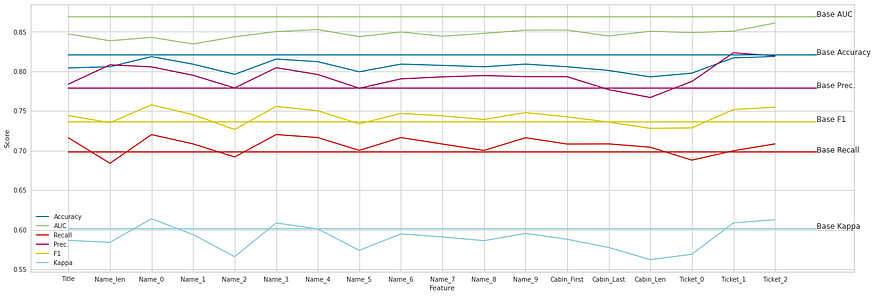
What Are Baseline Models and Benchmarking For Machine Learning, Why We Need Them? Part 1 Classification
Last Updated on July 26, 2023 by Editorial Team
Author(s): Hasan Basri Akçay
Originally published on Towards AI.
Machine Learning
Random, Machine Learning, Automated ML Baseline Models and Benchmarking For ML…

We can train a machine learning model with any prepared data but how can we be sure about the machine learning model learned from train data? The objective of this article is to explain baseline models in data science.
You can see the dataset here and you can see full python code at the end of the article.
What is Baseline Model?
The baseline models are references for our trained ML models. With baseline models, data scientists try to explain how their trained model is good and the score of the baseline model is the threshold for the data scientist.
What are Types of Baseline Model?
There are three types of the baseline model that are Random Baseline Models, ML Baseline Models, and Automated ML Baseline Models.
Random Baseline Models
In the real world, data can not always be predictable. In these such problems, the best baseline model is a dummy classifier or dummy regressor. That baseline model shows you to your ml model is learning or not. You can see how to use random baseline models below.
Firstly we create a random dataset for classification.
import pandas as pd
import numpy as npnp.random.seed(0)
random_dim = (1000,3)
random_X = np.random.random(random_dim)
random_reg_y = np.random.random(random_dim[0])
random_clf_y = np.random.randint(random_dim[1], size=random_dim[0])train_clf = np.concatenate((random_X, random_clf_y.reshape(random_dim[0], 1)), axis=1)
col_list = [str(i +1) for i in range(random_dim[1])]
col_list.append('target')
train_clf = pd.DataFrame(train_clf, columns=col_list)train_clf['target'] = train_clf['target'].astype('str')
train_clf

Then we compare machine learning models by using the pycaret compare_models function. According to the results, the best model is Dummy Classifier because there is no relationship between features and target.
from pycaret.classification import *clf = setup(data=train_clf,
target='target',
numeric_features=col_list[:-1],
silent=True)compare_models(sort='Accuracy')

Machine Learning Baseline Models
If data is predictable, the second step is to create an ml baseline model. This baseline model shows us which feature is important for prediction and which is not. Generally, ml baseline models use with feature engineering.
1. Baseline Scores
The first step is score calculations of the baseline ml model.
from pycaret.classification import *
CAT_FEATURES = ['Sex', 'Embarked']
NUM_FEATURES = ['Pclass', 'Age', 'SibSp', 'Parch', 'Fare']
IGN_FEATURES = ['PassengerId', 'Name', 'Ticket', 'Cabin']
clf = setup(data=titanic_train,
target='Survived',
categorical_features = CAT_FEATURES,
numeric_features = NUM_FEATURES,
ignore_features = IGN_FEATURES)baseline_model = create_model('rf')
baseline_preds = predict_model(baseline_model, raw_score=True)
baseline_preds

2. Feature Engineering
In this part, we add new features to the dataset.
import re
from sklearn.feature_extraction.text import TfidfVectorizer
from sklearn.decomposition import TruncatedSVD
# Name
titanic_train_FeaEng = titanic_train.copy()
name_last = titanic_train_FeaEng['Name'].str.split(' ', n=1, expand=True)[1]
title = name_last.str.split(' ', n=1, expand=True)[0]
titanic_train_FeaEng['Title'] = title
name_len = titanic_train_FeaEng['Name'].str.len()
titanic_train_FeaEng['Name_len'] = name_len
# Cabin
cabin_first = []
cabin_last = []
cabin_len = []
for cabin in titanic_train_FeaEng['Cabin']:
try:
re_list = re.split('(\d+)',cabin)
if len(re_list) > 1:
cabin_first.append(re_list[0])
cabin_last.append(int(re_list[-2]))
cabin_len.append(len(re_list))
else:
cabin_first.append('None')
cabin_last.append(0)
cabin_len.append(0)
except:
cabin_first.append('None')
cabin_last.append(0)
cabin_len.append(0)
titanic_train_FeaEng['Cabin_First'] = cabin_first
titanic_train_FeaEng['Cabin_Last'] = cabin_last
titanic_train_FeaEng['Cabin_Len'] = cabin_len
...
3. Features Importance
After feature engineering, we will add new features to the dataset one by one and we look at the score of baseline machine learning. If we have a better score, it means the new feature is good for predictions.
feature_score_dict = {}
for index, feature in enumerate(new_features):
old_features_temp = old_features.copy()
old_features_temp.append(feature)
titanic_train_FeaEng_temp = titanic_train_FeaEng[
old_features_temp].copy()
clf = setup(data=titanic_train_FeaEng_temp,
target='Survived')
baseline_model = create_model('rf')
scores = pull()
feature_score_dict[feature] = scores
4. Score Data Preparations
In this part, we prepare the dataset that includes scores for visualization.
metric_list = []
feature_list = []
score_list = []
for key in feature_score_dict.keys():
metric_list.extend(list(feature_score_dict[key].columns))
score_list.extend(list(feature_score_dict[key].loc['Mean', :]))
feature_list.extend([key for i in range(len(feature_score_dict[key].columns))])
all_scores_pd = pd.DataFrame()
all_scores_pd['Metric'] = metric_list
all_scores_pd['Feature'] = feature_list
all_scores_pd['Score'] = score_list
5. Visualization
import matplotlib.pyplot as plt
import seaborn as sns
col_list = ['Accuracy', 'AUC', 'Recall', 'Prec.', 'F1', 'Kappa']
score_color = {'Accuracy':'C0', 'AUC':'C1', 'Recall':'C2', 'Prec.':'C3', 'F1':'C4', 'Kappa':'C5'}...

Automated Machine Learning Baseline Models
The final baseline model is the automated ml baseline model. It is a very good model for benchmarking your ml model. If your ml model is better than the automated baseline model, it is a very strong sign that the model can become a product.
1. LightAutoML
Firstly we install and import the lightautoml library.
%%capture
!pip install -U lightautoml# Imports from our package
from lightautoml.automl.presets.tabular_presets import TabularAutoML, TabularUtilizedAutoML
from lightautoml.dataset.roles import DatetimeRole
from lightautoml.tasks import Task
import torch
After that, we prepare the task, role, and metric for the lightautoml library.
from sklearn.metrics import accuracy_score
from sklearn.metrics import f1_score
N_THREADS = 4 # threads cnt for lgbm and linear models
N_FOLDS = 5 # folds cnt for AutoML
RANDOM_STATE = 42 # fixed random state for various reasons
TEST_SIZE = 0.2 # Test size for metric check
TIMEOUT = 300 # Time in seconds for automl run
np.random.seed(RANDOM_STATE)
torch.set_num_threads(N_THREADS)
def acc_score(y_true, y_pred, **kwargs):
return accuracy_score(y_true, (y_pred > 0.5).astype(int), **kwargs)
def f1_metric(y_true, y_pred, **kwargs):
return f1_score(y_true, (y_pred > 0.5).astype(int), **kwargs)
task = Task('binary', metric = acc_score)
roles = {
'target': 'Survived',
'drop': ['Passengerid', 'Name', 'Ticket'],
}
Now, we can calculate the cross-validation score by using the below code.
%%time
from sklearn.model_selection import StratifiedKFold
n_fold = 3
skf = StratifiedKFold(n_splits=n_fold)
skf.get_n_splits(titanic_train)
...print('lightautoml_acc_score: ', lightautoml_acc_score)lightautoml_acc_score: 0.7957351290684626
2. H2O AutoML
Firstly we import the h2o library.
import h2o
from h2o.automl import H2OAutoMLh2o.init()

Now, we can calculate the cross-validation score by using the below code.
%%time
acc_list = []
for train_index, test_index in skf.split(titanic_train, titanic_train['Survived']):
X_train, X_test = titanic_train.loc[train_index, :], titanic_train.loc[test_index, :]
y = X_test['Survived'].astype(int)
X_test.drop(['Survived'], axis=1, inplace=True)...print('h2o_tautoml_acc_score: ', h2o_tautoml_acc_score)h2o_tautoml_acc_score: 0.8271604938271605
3. Visualization
After calculation of score of the auto ml models. Now, you can see scores that you should pass for strong ml production below.
fig, ax = plt.subplots(figsize=(24, 8))
ax.plot([0, 10], [h2o_tautoml_acc_score, h2o_tautoml_acc_score], color='r')
ax.text(10, h2o_tautoml_acc_score, 'Base_H2O')
ax.plot([0, 10], [lightautoml_acc_score, lightautoml_acc_score], color='r')
ax.text(10, lightautoml_acc_score, 'Base_LightAutoMl');

In this part of the article, we talked about baseline model types in classification problems. In the second part of the article, we will talk about baseline models in regression problems.
You can see full python code and all plots from here U+1F449 Kaggle Notebook.
U+1F44B Thanks for reading. If you enjoy my work, don’t forget to like it, follow me on Medium and LinkedIn. It will motivate me in offering more content to the Medium community! U+1F60A
References:
[1]: https://www.kaggle.com/hasanbasriakcay/baseline-models-clf-random-ml-automl
[2]: https://www.kaggle.com/c/titanic/data
[3]: https://pycaret.gitbook.io/docs/
[4]: https://lightautoml.readthedocs.io/en/latest/index.html
[5]: https://docs.h2o.ai/h2o/latest-stable/h2o-docs/automl.html
More…
Welcome, 2022U+1F389. What Has Changed in Data Science in 2021?
Best Data Science Tools, Methods, and Techniques such as Cloud Computing Product, Automated ML Tools, Courses, IDEs…
medium.com
What Are The Differences Between Data Scientists That Earn 500U+1F4B2 And 225.000U+1F4B2 Yearly?
This article is about important talents, tools, features of the country, and features of the company for high income in…
medium.com
5 Important Python Libraries and Methods For Data Scientists!
Most of the python libraries are already written for data science but newbies working in data science and machine…
medium.com
Olympic Medal Numbers Predictions with Time Series, Part 2: Data Analysis
Fbprophet, Darts, AutoTS, Arima, Sarimax, and Monte Carlo Simulation
medium.com
Join thousands of data leaders on the AI newsletter. Join over 80,000 subscribers and keep up to date with the latest developments in AI. From research to projects and ideas. If you are building an AI startup, an AI-related product, or a service, we invite you to consider becoming a sponsor.
Published via Towards AI
Take our 90+ lesson From Beginner to Advanced LLM Developer Certification: From choosing a project to deploying a working product this is the most comprehensive and practical LLM course out there!
Towards AI has published Building LLMs for Production—our 470+ page guide to mastering LLMs with practical projects and expert insights!

Discover Your Dream AI Career at Towards AI Jobs
Towards AI has built a jobs board tailored specifically to Machine Learning and Data Science Jobs and Skills. Our software searches for live AI jobs each hour, labels and categorises them and makes them easily searchable. Explore over 40,000 live jobs today with Towards AI Jobs!
Note: Content contains the views of the contributing authors and not Towards AI.














